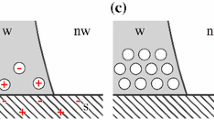Summary
The forced steady motion of the three phase contact line in model Langmuir-Blodgett systems is studied. Different “Y”-multilayers served to vary the dynamic behaviour of the contact perimeter at constant viscosity, density and surface tension of the subsolution. The specific velocity dependences of the receding contact angleϕ r and dynamic capillary heightL c stress the significance of the three phase contact line properties in the kinetics of wetting in the whole steady velocity range. The presentation of the experimental results in the Blake and Haynes theoretical scale confirms this conclusion.
The deviation from the theoretical trend observed with arachidic acid system at high velocities is related to the bulk drag force which becomes significant under these conditions. A model considering the drag force location in a receding meniscus at high withdrawal velocities is proposed, in which the Blake/Haynes relation is taken as a boundary condition of the bulk hydrodynamic problem. The latter is assumed to be similar to the problem of film entrainment by a moving solid wall. The experimental data show good agreement with the equation obtained on the basis of the proposed model.
Zusammenfassung
Es wird die erzwungene stationäre Bewegung der Dreiphasenkontaktlinie (DPKL) beim Aufbau von Langmuir-Blodgett-Systemen untersucht. Um die Rolle der dynamischen DPKL-Eigenschaften deutlich zu zeigen, sind Experimente mit verschiedenartigenY-Aufbauschichten unter konstanter Volumenviskosität, Volumendichte und Oberflächenspannung an der Lösung/Luft Phasengrenze durchgeführt worden. Die bei diesen Bedingungen gefundenen Abhängigkeiten des dynamischen Rückzugsrandwinkelϕ r , bzw. der dynamischen KapillarhöheL c von der Ziehgeschwindigkeit des Festkörpers unterscheiden sich voneinander. Dieses Ergebnis, sowie die gute Übereinstimmung der experimentellen Daten mit der Blake/Haynes-Theorie heben die Bedeutung der spezifischen DPKL-Eigenschaften für die Benetzungskinetik hervor. Die mit höheren Ziehgeschwindigkeiten auftretenden Abweichungen von dieser Theorie werden als Folge der mit der Geschwindigkeit ansteigenden Rolle der Volumenreibung in der Kraftbilanz des Systems diskutiert. Der rückziehende dynamische Meniskus wird in diesem Fall hydrodynamisch beschrieben, wobei das Blake/Haynes-Gesetz als Grenzbedingung verwendet wird. Die hydrodynamische Aufgabe wird als ähnlich der Aufgabe der dynamischen Benetzung betrachtet. Die erhaltene Gleichung ist in guter Übereinstimmung mit den experimentellen Daten bei den hohen Ziehgeschwindigkeiten.
Similar content being viewed by others
References
Blake, T. D., J. M. Haynes, J. Colloid Interface Sci.30, 421 (1969).
Hansen, R. J., T. Y. Toong, J. Colloid Interface Sci.37, 196 (1971).
Huh, C., L. E. Scriven, J. Colloid Interface Sci.35, 85 (1971).
Petrov, J. G., H. Kuhn, D. Möbius, J. Colloid Interface Sci.73, 66 (1980).
Blodgett, K., J. Amer. Chem. Soc.57, 1007 (1935).
Fromherz, P., Rev. Sci. Instrum.46, 1380 (1975).
Gaines, G. L. Jr., „Insoluble Monolayers at Liquid-Gas Interfaces”, p. 219, Interscience (New York 1966).
Clint, J. H., T. J. Walker, J. Colloid Interface Sci.47, 172 (1974); G. L. Gaines, Jr., J. Colloid Interface Sci.59, 438 (1977).
Sheludko, A., Ann. Sof. Univ., Fac. Chim.66, 99 (1971/72).
Schwartz, A. M., S. B. Tejada, J. Colloid Interface Sci.38, 359 (1972).
Friz, G., Z. Angew. Phys.19, 374 (1965).
Landau, L., V. G. Levich, Acta phys.-chim. USSR17, 42 (1942); see also V. G., Levich, “Physico-Chemical Hydrodynamics”, § 133, chap. XII, Prentice Hall (Engelwood Cliffs, 1962).
Deryagin, B. V., Zh. Eksp. i Teoret. Fiz. USSR,15, 9 (1945); see also B. V. Deryagin, S. M. Levi, “Film Coating Theory”, 1964, p. 25, Focal Press (London, New York).
Deryagin, B. V., in: “Uspechi Kolloidnoi Chimii”, Nauka, Moskwa, 1973, P. 34; see also P. Groenveld, Chem. Eng. Sci.25, 1259 (1970).
Author information
Authors and Affiliations
Rights and permissions
About this article
Cite this article
Petrov, J.G., Radoev, B.P. Steady motion of the three phase contact line in model Langmuir-Blodgett systems. Colloid & Polymer Sci 259, 753–760 (1981). https://doi.org/10.1007/BF01419321
Received:
Issue Date:
DOI: https://doi.org/10.1007/BF01419321




